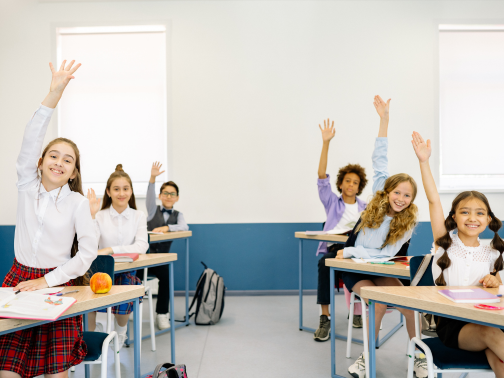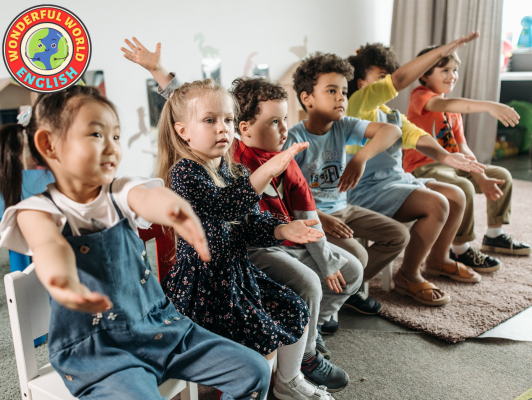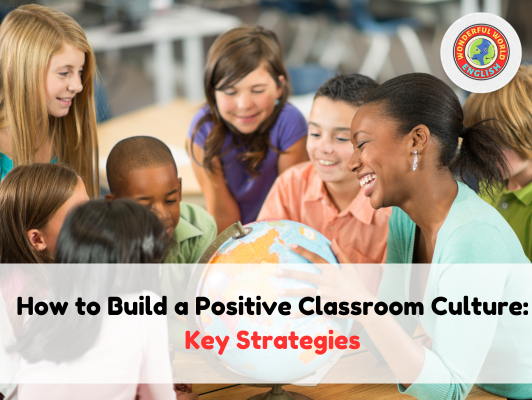Contents
Toggle
Meet David De’ Ath, founder, editor, and writer at Wonderful World English. With his extensive background as an English teacher, David provides valuable insights and practical tips on ESL for students and teachers alike.
Crafting a positive classroom culture is a critical component of educational success.
It shapes the learning environment, influences student behavior, and can either enhance or impede the educational process.
A classroom that exudes positivity nurtures student engagement, collaboration, and individual growth.
Teachers are the architects of this environment and have the power to set the tone for respect, encouragement, and mutual support.
Creating such an environment requires educators to be deliberate in developing clear structures and expectations.
This consistency provides a stable foundation where students can thrive.
Further, incorporating strategies to enhance engagement and collaboration promotes a connected and inclusive classroom community.
By promoting a growth mindset and responsibility, teachers empower students to take ownership of their learning and persist through challenges.
Integrating effective communication and emotional intelligence within the classroom dynamics is also paramount, as it leads to a more understanding and empathetic classroom culture.
Key Takeaways
- A positive classroom culture significantly affects the learning environment and student behavior.
- Consistent structures and clear expectations are fundamental for student growth and classroom stability.
- Emotional intelligence and effective communication are key to fostering an inclusive and supportive educational atmosphere.
Establishing a Community-Focused Classroom
Creating a community-focused environment in the classroom is essential for cultivating a sense of belonging and support among students.
Teachers focus on inclusivity, relationships, and a safe space to promote a positive classroom culture where every student feels like an integral part of the community.
Inclusivity and Diversity
Teachers must actively encourage inclusivity in the classroom, ensuring that students from all backgrounds feel valued and respected. This includes:
- Cultural Representation: Incorporating a diverse range of perspectives in educational materials and classroom discussions.
- Encouragement of Voices: Creating opportunities for all students to share their thoughts and experiences, thus validating their presence in the classroom.
Educators can explore techniques to establish a positive classroom culture that promotes respect, collaboration, and inclusivity.
Building Relationships and Trust
Building strong relationships founded on trust is key to a harmonious classroom environment.
Effective strategies involve:
- Regular Check-ins: Having individual or group discussions to understand each student’s needs and challenges.
- Collaborative Projects: Engaging students in group work to enhance interpersonal skills and peer connections.
By building meaningful community in classrooms, educators foster a unified group identity.
Creating a Safe and Supportive Space
A safe and supportive classroom is one where students are free to express themselves without fear of judgment or harm. This is achieved by:
- Clear Guidelines: Establishing and enforcing classroom rules that promote respect and prevent bullying.
- Open Communication: Maintaining an open-door policy for students to discuss personal and academic concerns.
Creating a positive classroom culture can lead to increased student motivation and a reduction in behavioral issues.
Related: ESL Teaching Strategies: Engaging the Modern Learner

Developing Clear Structures and Expectations
It is crucial to establish a framework where students understand what is expected of them academically and behaviorally.
The right balance of structure and flexibility fosters an environment of respect, responsibility, and productivity.
Setting Academic and Behavioral Expectations
Teachers should begin by outlining specific academic standards that students are expected to meet and, just as importantly, behavioral norms that create a respectful and safe learning environment.
Academic expectations might include submission timelines for assignments, participation in group discussions, or standards for project collaboration.
Meanwhile, behavioral expectations could revolve around respectful communication, active listening, or the protocol for seeking help when needed.
- Academic Expectations:
- Adherence to project timelines
- Engagement in discussions
- Quality of collaborative work
- Behavioral Expectations:
- Respect for peers and staff
- Active participation without interrupting
- Appropriate procedures for help-seeking
Linking expectations to clear outcomes helps students see the relevance of their efforts, promoting a deeper engagement with the class material and with each other.
Consistency and Routines in Classroom Management
Consistency in enforcing rules and routines is pivotal for maintaining clear expectations in the classroom.
Daily routines, from the beginning of the class with a warm-up exercise to the end with a summary of key learnings, help cement the structure.
Students thrive when they know the sequence of a typical day and understand the consequences of not aligning with the set guidelines.
- Daily Routines:
- Morning check-ins or warm-ups
- Scheduled group activities
- End-of-day recap and homework explanation
- Classroom Management Keys:
- Fair and consistent enforcement of rules
- Transparent system for tracking and reflecting on behavioral expectations
- Predictable consequences for infractions
Through repeated practice and positive reinforcement, these routines become second nature, contributing to a well-ordered and empowering classroom culture.

Enhancing Engagement and Collaboration
In the heart of a thriving classroom, one finds students actively engaged and collaboratively working on projects that stimulate their curiosity and drive to learn.
Promoting Active Participation
Teachers can spark student engagement by designing lessons that require input from every individual.
A method to ensure active participation is the “think-pair-share” technique, which encourages students to think about a question individually, discuss their thoughts with a peer, and then share their conclusions with the class.
This approach gets students thinking and emboldens everyone to have a voice.
Implementing Group Work and Cooperative Learning
Cooperative learning can take form in structured group work, leading to enhanced teamwork skills.
To ensure effective collaboration, teachers might assign roles such as leader, recorder, and reporter within groups.
Establishing clear objectives and outcomes for each group project is crucial to guiding students toward productive interaction and collective goal attainment.
Using a table to allocate roles and responsibilities makes expectations clear and supports collaboration.
Games and activities promote collaboration and teamwork among students.
Check out the free guide below for some awesome games you can play in your classroom!
Related: Fun Classroom Games to Play

Cultivating a Growth Mindset and Responsibility
Cultivating a growth mindset and fostering responsibility are pivotal to building a positive classroom culture.
Educators need to focus on empowering students to take charge of their learning and understand the value of their contributions.
Encouraging Student Autonomy and Voice
Students thrive when they have a sense of autonomy in their learning process and when their voice is heard.
Teachers can encourage this by:
- Allowing students to set their own learning targets and take the lead in selecting projects that align with these goals.
- Establishing classroom discussions where every student’s voice is valued promotes the courage to speak up and the confidence to express themselves.
This approach motivates learners and instills a sense of responsibility and ownership of their education journey.
Acknowledging Milestones and Providing Feedback
Recognizing achievements and giving constructive feedback are integral to developing a growth mindset.
Here’s how educators can apply positive reinforcement:
- Create a clear and visible chart of milestones for each student, celebrating progress no matter the scale.
- Provide timely and specific feedback, emphasizing what has been done well and offering guidance on areas for improvement.
This method reinforces that effort is recognized and valued, which in turn encourages students to persevere and maintain their motivation.

Integrating Effective Communication and Emotional Intelligence
Effective communication and emotional intelligence are pivotal in shaping a positive classroom culture.
They enrich academic performance and foster positive relationships.
When students learn to communicate effectively and harness their emotional intelligence, they navigate social complexities with greater ease.
Practicing Active Listening and Empathy
Active listening and empathy are cornerstones for building trust and understanding in the classroom.
Active listening involves giving full attention to the speaker, acknowledging their message, and responding thoughtfully.
This practice encourages students to:
- Reflect on what is being said before responding
- Ask clarifying questions to ensure comprehension
- Show that they understand by summarizing or paraphrasing the information
Incorporating empathy means teachers and students strive to comprehend and share each other’s feelings, creating a supportive environment.
This fosters positive relationships and improves emotional well-being, contributing to a classroom where every student feels valued.
Promoting Open Communication and Emotional Well-being
Open communication is essential for expressing thoughts and feelings in a constructive manner.
Teachers can encourage this by:
- Creating opportunities for students to share their opinions and experiences
- Establishing classroom norms that respect diverse perspectives
- Teaching conflict resolution skills through role-play and real-life scenarios
Simultaneously, nurturing students’ emotional well-being is key to sustaining academic performance.
This can be achieved through activities that promote self-awareness and regulate emotions, such as:
- Journaling to reflect on personal emotions and experiences
- Group discussions about feelings and how they affect interactions
Integrating these practices helps to create a learning environment where communication and emotional intelligence are interwoven, laying a foundation for lasting academic and interpersonal success.

Conclusion
In conclusion, building a positive classroom culture is a continuous process requiring effort, commitment, and collaboration between students and teachers.
Teachers can cultivate a classroom culture where students feel valued, supported, and motivated to learn by creating a safe and inclusive environment and encouraging inclusion and teamwork.
Any teacher can properly forge a positive classroom culture by following this article’s advice.
It’s important to remember that a positive classroom culture enhances academic achievement and contributes to student’s holistic development, preparing them for success in the future.
We hope you find value in this information; you can contact us if you require any support.
Have a wonderful day!
Image Attribution: All images licensed via canva.com





